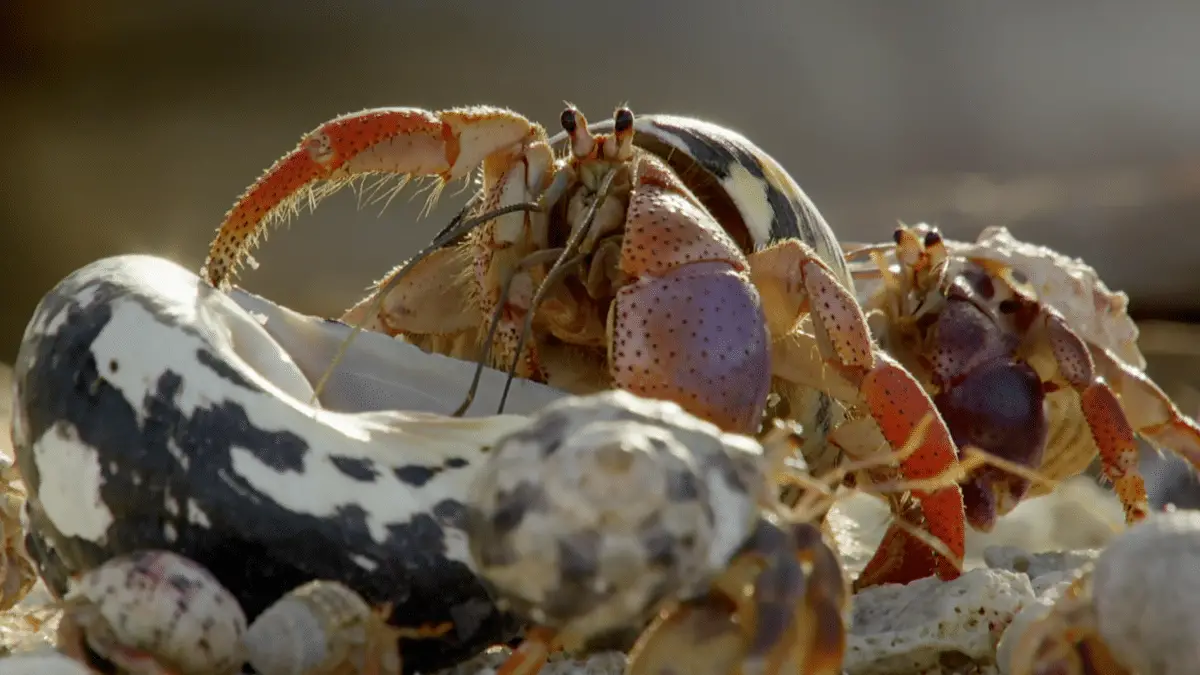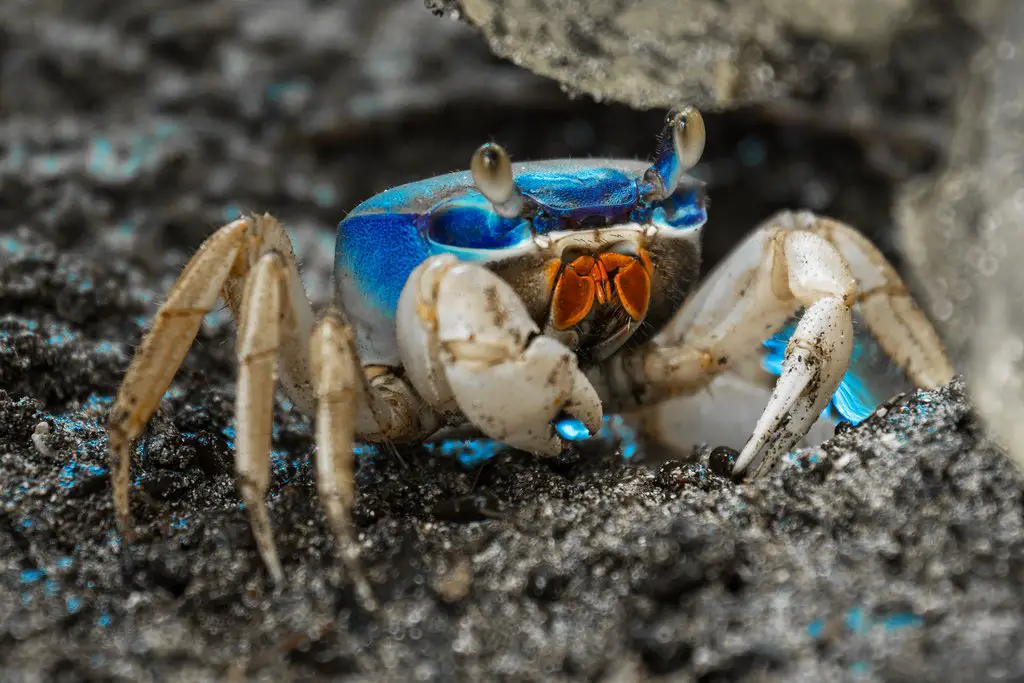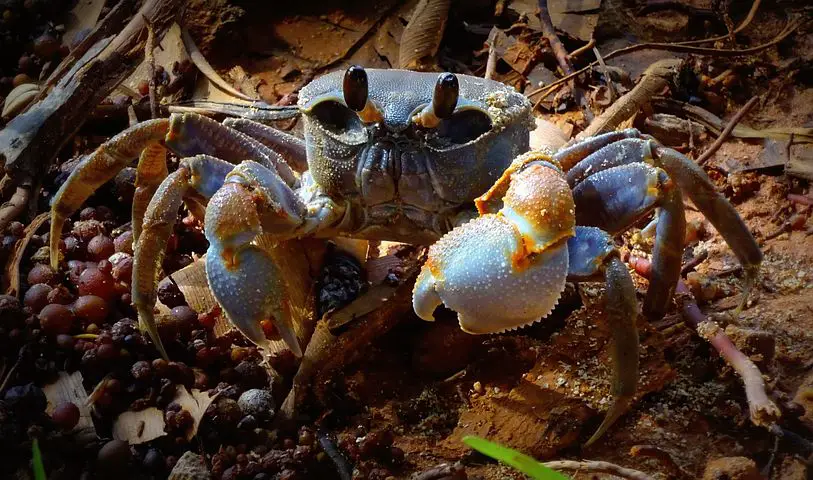Are Hermit Crabs Easy To Take Care Of

Introduction
Are Hermit Crabs Easy To Take Care Of: The allure of hermit crabs as captivating, low-maintenance pets has made them a popular choice among pet enthusiasts, particularly those new to the world of pet ownership. The question that often arises is whether hermit crabs are truly easy to take care of, and this inquiry opens the door to explore the delightful realm of hermit crab care.
Hermit crabs, scientifically classified as Coenobita spp., are intriguing crustaceans known for their habit of adopting empty gastropod shells as portable homes. They are often praised as suitable crab pets for beginners due to their relatively straightforward care requirements and engaging behaviors. However, a closer examination reveals that successful hermit crab husbandry entails specific considerations.
In our exploration, we will delve into the aspects that make hermit crabs accessible to novice pet owners. We will also unveil the essential elements of hermit crab care, ranging from habitat setup to dietary needs. The journey of understanding whether hermit crabs are easy to care for unveils not only their charm but also the responsibilities that come with providing a nurturing and fulfilling environment for these unique and endearing crustaceans.

Are hermit crabs hard to keep alive?
Hermit Crabs are wonderful pets that are easy to look after. The hermit crab has evolved to be able to live on land with the use of empty shells as a home and protection. With the right care, your hermit crab can live up to approximately 15 years.
Keeping hermit crabs alive can be manageable with proper care, but it does require attention to specific details. Hermit crabs are sensitive creatures, and their well-being depends on creating a suitable environment that mimics their natural habitat.
One of the critical factors in hermit crab care is maintaining the right temperature and humidity levels. Hermit crabs are tropical creatures, so their enclosure should ideally have a temperature between 75-85°F (24-29°C) and humidity levels of 70-80%. Inadequate temperature or humidity can lead to stress, dehydration, and health issues.
Providing a varied diet is another essential aspect. Hermit crabs are scavengers and need a mix of foods, including commercial hermit crab pellets, fresh fruits, vegetables, and a source of calcium, like crushed eggshells. A lack of proper nutrition can lead to molting problems and decreased vitality.
Ensuring a suitable habitat with appropriate substrates for digging and molting is crucial. Molting is a vulnerable time for hermit crabs, so they require privacy and proper conditions to molt successfully.
Lastly, handling should be kept to a minimum as it can cause stress and damage to their delicate exoskeletons.
Hermit crabs are not necessarily hard to keep alive, but they do require a dedicated commitment to their specific needs. With proper care, they can thrive in captivity, providing their keepers with the enjoyment of observing these unique and fascinating creatures.
Are hermit crabs good beginner pets?
Hermit crabs can be relatively low-maintenance, but they have strict housing and care requirements. They will not live more than a year without meeting these requirements, whereas ones living under proper care can live 10 years or longer. They should never be considered “throwaway pets.”
Hermit crabs are often considered suitable beginner pets for individuals looking to venture into the world of pet ownership, primarily due to their manageable care requirements and fascinating behaviors. Here are some reasons why hermit crabs can be good pets for beginners:
- Low Cost: Hermit crabs are generally affordable to purchase, and their initial setup costs are relatively modest. This makes them accessible to those on a budget.
- Low Maintenance: Hermit crabs do not require extensive daily care. Regular tasks include providing food, maintaining humidity, and ensuring a clean environment. They are not demanding in terms of attention or interaction.
- Educational Value: Keeping hermit crabs can be an educational experience, especially for children. It teaches responsibility and provides an opportunity to observe natural behaviors and molting processes.
- Compact Size: Hermit crabs are small and do not need a lot of space, making them suitable for individuals with limited living space.
- Fascinating Behavior: Hermit crabs exhibit intriguing behaviors, such as changing shells and digging, which can be captivating to observe.
- Community Pets: Hermit crabs are social animals and often thrive when kept in groups, allowing for a dynamic and interesting habitat.
While hermit crabs can be great pets for beginners, it’s essential to research and understand their specific needs, including appropriate housing, diet, and humidity levels, to ensure their well-being. Providing a suitable environment and proper care will help ensure that beginner pet owners have a positive and rewarding experience with these unique crustaceans.
Why are hermit crabs hard to take care of?
Hermit crabs need companionship, plenty of climbing room, substrate to bury themselves in for molting, humidity, warm temperatures, extra shells, fresh and salt water (dechlorinated aquarium salt only), and much, much more!
Taking care of hermit crabs can prove challenging due to several factors. Firstly, their habitat complexity demands attention. To ensure their well-being, a carefully designed enclosure with both land and water components is essential. Achieving and maintaining the right conditions, including temperature, humidity, and substrate, can be intricate and require constant monitoring.
Secondly, hermit crabs undergo regular molting, a process during which they shed their exoskeletons to facilitate growth. Molting is a vulnerable time, and hermit crabs need a quiet and secure environment to complete it successfully. Disturbances during this process or inadequate conditions can result in molting complications and potential fatalities.
Addressing their dietary needs can be another challenge. Hermit crabs are omnivores, necessitating a varied diet comprising commercial hermit crab food, fresh fruits, vegetables, and calcium sources like crushed eggshells. Achieving the right balance can be intricate, and improper nutrition can lead to health issues.
Lastly, hermit crabs have long lifespans, and as they grow, they require larger shells for shelter. Finding suitable shells and ensuring they are available as the crabs grow can be an ongoing task. These challenges, while surmountable with research and dedication, make hermit crab care more intricate than it may initially appear.
Do hermit crabs need land?
Land hermit crabs live close to the shoreline and must have access to both land and water. They use pools and crevices of sea water to wet their gills and the interiors of their shells, and they reproduce and spend their early stages in water. Other hermit crab species are entirely aquatic.
Hermit crabs do need land as an essential part of their habitat. While they are often associated with marine environments, hermit crabs are not true aquatic creatures; they are actually terrestrial and semi-terrestrial in nature. Providing access to both land and water is crucial for their well-being. Here’s why land is essential for hermit crabs:
- Molting: Hermit crabs molt, a process where they shed their exoskeletons to grow. Molting occurs on land, where they bury themselves in the substrate. A suitable land area is necessary for them to safely undergo this vulnerable process.
- Rest and Safety: Hermit crabs spend a significant portion of their time on land. It provides a place for them to rest, escape potential predators, and find protection from other crabs. Without access to land, they can become stressed and vulnerable.
- Shell Changing: Hermit crabs frequently change shells as they grow. They need a stable platform on land to make these transitions, as changing shells in water can be risky.
- Social Interaction: Hermit crabs are social animals and often gather on land. Land areas allow them to interact with each other, engage in hierarchical behaviors, and establish a sense of community.
- Feeding: Hermit crabs may forage for food on land, especially for fruits and plant material. Access to both land and water ensures a varied diet.
Land is a crucial component of a hermit crab’s habitat, serving multiple purposes, including molting, resting, safety, shell changing, social interaction, and feeding. Providing a suitable land area is essential for the well-being and overall health of hermit crabs kept in captivity.
What is the easiest crab to care for?
Fiddler crabs are low maintenance and are usually kept in small to medium-sized aquariums. They are fun pets to watch and can live for up to ten years. Once you understand the basics, taking care of your fiddler crab is easy.
- Hermit Crab Basics: Hermit crabs are fascinating crustaceans known for their habit of using discarded shells as portable homes. They belong to the family Coenobitidae and are primarily found in tropical and subtropical regions around the world. Unlike true crabs, they have soft abdomens, which they protect by occupying empty gastropod shells.
- Land Hermit Crabs: Land hermit crabs, specifically Coenobita spp., are commonly kept as pets due to their relatively low maintenance requirements. They are adaptable to terrestrial environments, spending time both on land and in shallow water. This versatility makes them accessible to a wide range of pet owners, including beginners.
- Habitat and Care: Caring for land hermit crabs involves providing them with an enclosure that includes a suitable substrate for burrowing, a heat source to maintain the proper temperature and humidity, access to fresh and saltwater for drinking and bathing, and a variety of shells for them to change into as they grow. They are omnivores, requiring a diet that includes commercial hermit crab food, fresh fruits and vegetables, and a source of calcium.
- Social Creatures: Hermit crabs are social animals and thrive when kept in groups. They engage in interesting behaviors, such as grooming and climbing over each other. Ensuring proper social interaction among them is an essential aspect of their care.
- Educational Pets: Keeping hermit crabs as pets can be an educational experience, particularly for children, as it offers insights into marine biology, behavior, and the importance of responsible pet ownership. Properly caring for these captivating creatures requires attention to detail, but the rewards include the opportunity to observe their unique behaviors and personalities up close.
What kind of habitat and enclosure do hermit crabs need?
Creating the right habitat and enclosure is crucial for the well-being of hermit crabs. Here are key elements to consider:
- Terrarium or Tank: A glass or plastic enclosure with a secure lid is essential to prevent escapes and maintain proper humidity levels. The size of the enclosure should be appropriate for the number of hermit crabs you plan to keep. A 10-gallon tank is a suitable starting point for a small group.
- Substrate: Provide a substrate that allows for burrowing. A mixture of coconut coir, play sand, and sphagnum moss works well. Ensure it is deep enough for hermit crabs to dig and molt comfortably.
- Temperature and Humidity: Maintain a temperature range of 75-85°F (24-29°C) and humidity levels of 70-80%. A heat mat or heat lamp can help regulate temperature, while misting the enclosure and providing a shallow water dish with dechlorinated freshwater helps maintain humidity.
- Access to Water: Hermit crabs need both freshwater for drinking and saltwater for bathing. Offer dechlorinated freshwater in a dish and provide a separate saltwater dish made by mixing a marine aquarium salt mix with freshwater.
- Shells: Offer a variety of empty shells in different sizes and shapes to accommodate their growth. Ensure the shells are appropriate for the size of your hermit crabs.
- Diet and Food Dishes: Hermit crabs are omnivores and need a balanced diet. Provide commercial hermit crab food, fresh fruits, vegetables, and a calcium source like crushed eggshells. Use shallow dishes for food and water to prevent drowning.
- Decor and Enrichment: Add items like driftwood, rocks, climbing structures, and hides to create an engaging environment. Hermit crabs are curious and benefit from mental stimulation.
- Social Environment: Hermit crabs are social animals and thrive when kept in groups. Consider having at least two hermit crabs to ensure they have social interactions.
Remember to monitor the habitat’s conditions regularly and make adjustments as needed to ensure the health and well-being of your hermit crabs.
How do you maintain the proper temperature and humidity for hermit crabs?
Maintaining the proper temperature and humidity for hermit crabs is essential for their health and well-being. To achieve this, it’s crucial to employ a combination of tools and techniques.
Firstly, using a reliable heat source like a heat mat or heat lamp with a thermostat allows you to regulate the temperature inside the enclosure effectively. Positioning the heat source on one side of the tank creates a temperature gradient, enabling the hermit crabs to choose their preferred comfort zone.
Additionally, placing a thermometer and hygrometer inside the tank is indispensable. These instruments provide real-time data on temperature and humidity levels, allowing you to make necessary adjustments promptly.
To maintain humidity between 70-80%, daily misting of the substrate and tank walls with dechlorinated freshwater is crucial. Providing shallow dishes of freshwater for drinking and saltwater for bathing ensures that the hermit crabs have access to both essential types of water.
Lastly, keeping the tank securely covered while allowing for some ventilation helps retain heat and moisture. Ensuring that the substrate remains consistently moist but not waterlogged contributes to a stable and comfortable environment for your hermit crab companions. Regular monitoring and adjustments based on temperature and humidity readings are essential to create an optimal habitat for these fascinating crustaceans.
How often should I clean their habitat?
The frequency of cleaning a pet’s habitat largely depends on the type of animal, its living conditions, and your commitment to maintaining a healthy environment. In general, it’s essential to establish a regular cleaning routine to ensure your pet’s well-being.
For small animals like hamsters, gerbils, or fish, cleaning their habitats should be a weekly task. Regularly changing their bedding, cleaning their water and food dishes, and checking for any waste buildup is crucial to prevent health issues.
Reptiles and amphibians require a slightly less frequent cleaning schedule, typically every two to four weeks. This involves replacing their substrate, cleaning their enclosure, and disinfecting their water and food containers.
For larger pets like dogs and cats, daily cleaning tasks like scooping the litter box or picking up after walks are essential. A more thorough cleaning of their living areas should be done on a weekly basis.
Ultimately, the key is to monitor your pet’s habitat and adjust your cleaning schedule accordingly. Cleanliness not only keeps your pets healthy but also ensures a more pleasant living environment for both you and your furry or scaly friends.

Conclusion
The question of whether hermit crabs are easy to take care of yields a nuanced answer. While hermit crabs are often touted as suitable pets for beginners due to their manageable care requirements and engaging behaviors, it’s essential to recognize that ease of care is relative and hinges on responsible pet ownership.
The allure of hermit crabs lies in their compact size, affordability, and educational value, particularly for children. They offer opportunities for hands-on learning about marine biology and natural behaviors, making them a fascinating choice for novice pet owners with limited living space and budgets. Their low-maintenance routine, involving tasks like providing food, maintaining proper environmental conditions, and offering freshwater and saltwater, seems approachable.
However, the ease of hermit crab care is contingent upon a commitment to research and understanding their specific needs. Providing an appropriate habitat with land and water, closely monitoring temperature and humidity, and offering a balanced diet are essential components of their care. Neglecting these aspects can lead to challenges and health issues.
In essence, hermit crabs can be easy to take care of for those willing to invest time and effort into responsible husbandry. They offer a rewarding experience that blends the joy of observation with the responsibilities of nurturing these captivating crustaceans. For novice pet owners, hermit crabs can serve as delightful companions, bridging the gap between introductory pet ownership and the broader world of animal care.



